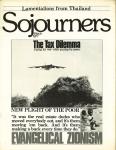Driving at night through downtown Washington, D.C., among the shadows of the buildings that during the day house the Departments of State, Interior, and Justice, one cannot help noticing the groups of women and men huddled together over the steam-engulfed steel gratings that cover the hot air ducts outside these buildings. Those who find enough warmth on the grates outside the Corcoran Art Gallery--enough to survive the District’s raw winter nights, the coldest in 50 years--are the closest neighbors of the new family in the White House, only a block away. Many others crouch in doorways in front of abandoned buildings that dot the city’s neighborhoods, stand shoulder-to-shoulder with others around fires in barrels and garbage cans in vacant lots, sleep in parked or abandoned cars, try to remain unnoticed by police in order to catch a couple of hours of sleep in one of the bus terminals attempting to keep hands and feet warm, to stay alive. At least eight persons have died from exposure since the first of last December.
Scenes such as these are extreme, but all too real, representations of Washington’s housing crisis. Slightly less visible but just as immediate are the thousands of families who are evicted from their homes each year, many of them victims of speculation and urban renewal. On any given day hundreds of people are sleeping in parks, boarded-up buildings, and empty cars. In 1975 alone, there were 2,260 families evicted from their homes. Because of development pressures and the considerable impact of broad economic forces and unemployment on a city with many poor residents, the eviction rate has increased more than 600% in the last year. Thousands are homeless.
This crisis exists in the face of thousands of abandoned buildings owned by the D.C. Redevelopment Land Agency and absentee landowners. The city holds the deed to an estimated 5,000 vacant houses. These buildings are not just symbols of physical decay, they are monuments to moral, economic, and political evil. More than that they are a taunt, a jeer in the face of the homeless.
The assistance offered to evicted families by the city is wholly inadequate--three days shelter at a motel for a few, nothing for most. The District government operates only two emergency shelter facilities, with a maximum capacity of ten moderate size families each. Some families are able to separate and crowd in with friends and relatives, others are literally put in the street. It is not uncommon to see a family’s possessions stacked along a street curb, if not thrown from a window. Even worse, the city commonly offers jobs emptying belongings from homes to those most desperate for employment and themselves often living on the street.
Further, available public housing does little to meet the needs of low-income families, and short-term rent subsidies provide little security to those who can afford what is available. As an example, the ribbon-cutting ceremonies for two large apartment buildings rehabilitated in the heart of an urban renewal project were recently called off when it was discovered that the units, even with unusually high subsidization of rents, would not be affordable for low income families. With the subsidies set to expire in five years, even moderate-income families would be hard-pressed to remain in the buildings.
In the District of Columbia, it is estimated that 77,000 people--one in ten--are living in substandard, over crowded housing. The city has one of the tightest and most expensive housing markets in the country. The occupancy rate is 99%; HUD defines a 95% rate as critical. The housing market is clearly a seller’s market, with ability to acquire based on ability to pay.
It is this situation which is displacing families and individuals, and forever locking those most in need out of their neighborhoods. As an area becomes more attractive in the eye of the speculator, property is acquired for future use and often sits idle. These vacant, boarded-up eyesores breed rats, trash, crime, and do active violence to those who must live around them.
As development plans blossom and title is gained to even more real estate, families are soon evicted from their homes and their neighborhood. Renovation of property begins--done with the primary goal of maximizing profits. In addition to controlling a vast number of boarded-up buildings, the city’s policy of selling packages of property to real estate developers intensifies the problem. Whole blocks and streets are sold in a single unit and are often ultimately bulldozed away. The “master plan” is to remove those in the most fragile position with regard to the basic need of shelter, and to transplant those with higher incomes into neighborhoods with transformed housing prices. The overhaul of neighborhoods and their occupants has far-reaching benefits for profit-seekers. The present agenda is not to insure adequate housing for all, but the monetary benefit of a few.
Out of an understanding of these conditions the Community for Creative Nonviolence moved to act. Last April, as related in Jim Wallis’s editorial this issue, a proposal was submitted to the city requesting that a large multi family dwelling be made available for use as an emergency shelter for evicted families and homeless individuals C.C.N.V. offered to rehabilitate and operate the shelter with the Community’s own labor and funds, at no cost to the city.
In June, when housing officials rejected the offer to take a building abandoned nine years and use it to begin to help meet the immediate basic need, a serious political effort to acquire the property ensued. The city rejected the proposal because of the precedent it would set, as well as their unwillingness to release a property that would bring in “less than the fair reuse appraisal value.” C.C.N.V. had to remind the Department of Housing and Community Development that it is not private real estate agency dedicated solely to a profit and loss statement.
In addition to failing to meet the needs of those it is charged with serving, the agency was blocking an offer by a community organization to help to do just that. A Washington Post columnist was later to report, “The house has become more than a potential shelter for the poor. It is a symbol of all the abandoned houses in the city that mock the needs of citizens.”
A key element of the proposal for the shelter, as well as being an effort to address the larger issues involved in the housing crisis, was the establishment of a neighborhood land trust. C.C.N.V. has sought to have title to the property given to the recently established Columbia Heights Community Ownership Project--one of the nations’s first urban land trusts. The non-profit trust takes as its four main purposes: 1) to halt real estate speculation in the neighborhood before a major transformation of rent levels and sale prices occurs, by taking abandoned or low-cost housing off the market; 2) to demonstrate that land and housing are not commodities to be bought and sold, but are the right of all; 3) to provide low-cost adequate housing for low-income residents of the neighborhood; and 4) to place the control of the future of the neighborhood in the hands of the residents through community ownership of resources.
The trust, now in its initial stages of development, has recently purchased its first property. Volunteers are under taking major rehabilitative work on it. The home will then be leased to a neighborhood family in need of low-cost housing. Alternative means of financing made possible the purchase of the first property. They will be key to purchasing more houses and financing the needed work on them.
Title to property will be held by the trust. The land trust, to be composed of an elected board of directors of neighborhood residents, community leaders, and trust leaseholders, will offer 99-year renewable leases to families, providing the security of private owner ship with the benefits of community control. Tenants’ monthly payments will be based on ability to pay, balanced with the trust’s ability to subsidize. Those with the greatest need for housing will be chosen as tenants. Equity will be accrued in the form of the security of permanence--a home that cannot be taken away and a portion of all payments will be set aside for relocation or emergency expenses. Building a diverse, yet cohesive, structure that can unite people in the context of their ties as a neighborhood is the goal.
This unique perspective toward relationship with the land and neighbors is summarized in the Statement of Purpose:
Community ownership of land stands firmly rooted in the traditions of Native Americans and African tribes, and it also has strong spiritual ties to biblical concepts. The land was here long before our birth, and it will remain when we are no longer a memory. It is our responsibility to care rationally and humanely for this vital natural resource entrusted to us. Like the air and the water, the land is held commonly by us all. It is to be respected, to be used as needed with wisdom and concern for those with whom we share it, now and in the future.
Those involved in this ongoing campaign for housing have grown together in the struggle with unresponsive city and church officials. They have grown internally as the call for personalism in responding came to individual minds and hearts, and engendered a collective response. The campaign was significant in its combination of a personal approach, constructive program, and political struggle. Individuals began to feel the need to respond in a clear personal way to this crisis situation, and a group action was undertaken for creating a positive alternative in housing people and building a new order of relationships to the land and among its occupants. The hope, sometimes realized, was that each new political encounter would lead to reconciliation and friendship, possibly a change of heart.
The campaign continues to assist in providing shelter for homeless people, and to make every effort to build the neighborhood land-trust and begin to halt land speculation, by renewing the relationship with land in a decentralized and cooperative manner. The vision is strong, the path long.
When this article appeared, Mark Lee was a member of the Community for Creative Nonviolence in Washington, D.C.

Got something to say about what you're reading? We value your feedback!
